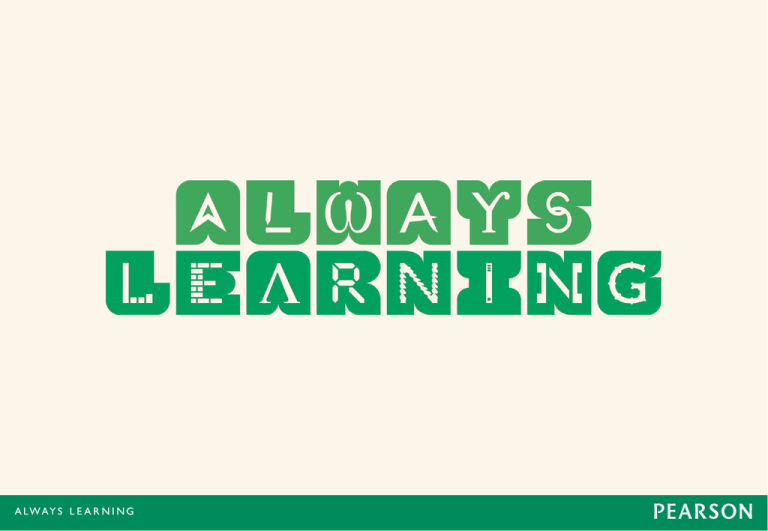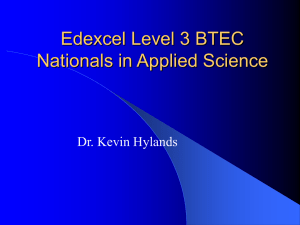AZpresentation_042213_AmEnglish
advertisement

The Arizona Move On Ready Initiative BTEC: an Introduction Presented by: Debbie Cole Andy Taylor 2 3 What is a BTEC? BTEC is a work related qualification suitable for a wide range of students. They provide a practical, real-world approach to learning alongside a theoretical background. Each BTEC is made up of units. Students study real-life, work-based case studies and complete projects and assessments. 4 What is BTEC? (cont.) In order to complete each unit, students must achieve against a set of outcomes. The assessment criteria address theory with practical exercises. The assessment process is ongoing, so it allows the student to analyze and improve their own performance through their course in much the same way as they would in a real workplace. The projects that students undertake form the basis of their unit results which are graded as a Pass, a Merit or a Distinction. 5 Key facts Qualifications delivered in 85 countries worldwide Award more than 1.1 million vocational qualifications The BTEC portfolio is exclusive to Edexcel including approximately 5000 standard qualifications More than 200 universities worldwide recognize Edexcel BTEC 6 History of BTEC 1960’s Started life as BEC and TEC (Business Education Council and Technology Education Council) 1980’s Merged into BTEC (Business and Technical Education Council) 1997 Edexcel created by merger of BTEC with ULEAC (University of London Examinations & Assessment Council) 2005 Pearson becomes owner 2008 1 million learners a year hit 2010 Latest specifications launched 2015 Next specification update 7 BTEC- Opening the doors to career and postsecondary BTEC Higher Nationals Levels 4 and 5 BTEC Firsts for Level 2 learners BTEC Nationals Level 3 GCSE and iGCSE A Level (GCE) Further and /or Higher Education BTEC Entry and Level 1 ‘Classic’ US High School education 8 Employment How do BTEC sizes and levels work? 1 credit ≈ 6 Guided Learning Hours 8 7 6 5 Difficulty 4 Size 3 2 Level 1 ENTRY AWARD 1 – 12 credits Size 9 CERTIFICATE 13 – 36 credits DIPLOMA Above 36 credits How do BTECs compare to academic programs? NCEE Upper division NCEE lower division 10 Credit, What are GLH and Learning Time? Credit is now being used across all levels of vocational qualifications in the English systems as a “currency”. Guided Learning Hours (GLH) is a notional measure of the amount of time when a member of staff is present to give guidance to a learner; it is not an exact science. Learning Time is associated with credit and the amount of time the average learner takes to achieve a passing mark. Learning time is approximately 10 x that of credit. 11 How specifically do Level 3 Nationals compare? BTEC Level 3 Nationals (QCF) BTEC Level 3 Extended Diploma 180 credits (1080 GLH or 15 hours GLH per week)* BTEC Level 3 Diploma 120 credits (720 GLH or 10 hours GLH per week)* BTEC Level 3 Subsidiary Diploma 60 credits (360 GLH or 5 hours GLH per week)* BTEC Level 3 Certificate 30 credits (180 GLH or 2.5 hours GLH per week)* * Assumption of 36 week year, course delivered over two years 12 = 3 A Level Courses = 2 A Levels = 1 A Level = 1 AS Level (1/2 A Level) School teaching models used internationally Full Vocational Pathway All teaching time used to deliver vocational and supporting programs, this would consist of 1 extended diploma plus supporting learning such as core subjects (math/English/languages/WorkSkills) Academic/Vocational Mix A mix of separate programs for which the vocational element would be up to 50% of learning – normally a diploma sized qualification 13 School teaching models used internationally Vocational Support for Academic Courses This is a new model arising in the UK and other countries where academic subjects are supported by using vocational equivalents as an introduction to (or side by side with )the academic version. For example, this model is used extensively in Science and Sports (to support human Biology and Physical education theory) 14 Changes for the US market • Phase 1 qualifications available for teaching Fall 2013 • Specifications will be localized and translated into American English • Teacher guides will use US relevant examples • Standard teacher and student books will continue to be available in British English for all qualifications 15 Which BTECs will be offered through Move On When Ready? Phase 1 – Specifications and teacher guides translated and localized: BTEC BTEC BTEC BTEC BTEC Level Level Level Level Level 3 3 3 3 3 in IT in Business Engineering Applied Science in Health and Social Care During this phase, WorkSkills level 2 and level 3 suites will also be available, though these will not be translated/localized. 16 The many flavors of business Cert. Subsidiary Diploma Diploma Extended Diploma Business Y Y Y Y Applied Law Y Y Business (Accounting) Y Y Business (Administration) Y Y Business (Human Resources) Y Y Business (Law) Y Y Business (Logistics) Y Y Business (Management) Y Y Business (Marketing) Y Y Business (Retail) Y Y Enterprise and Entrepreneurship Y Subject name Personal and Business Finance Understanding Enterprise and Entrepreneurship 17 Y Y Y The many flavors of engineering Subject name Cert. Subsidiary Diploma Aeronautical Engineering Engineering Y Y Diploma Extended Diploma Y Y Y Y Aircraft Maintenance Y Electrical/Electronic Engineering Y Y Manufacturing Engineering Y Y Mechanical Engineering Y Y Operations and Maintenance Engineering Y Y 18 The many flavors of science Subject name Applied Science Cert. Subsidiary Diploma Diploma Extended Diploma Y Y Y Y Applied Science (Applied Biology) Y Applied Science (Applied Chemistry) Y Applied Science (Applied Physics) Y Applied Science (Forensic Science) Y Y Y Applied Science (Medical Science) Y Y Y Dental Technology Y Pharmaceutical Science 19 Y 20 Professional Development and Training 4 day implementation training for each school Introduction to BTEC Webinar Online Administration Webinar Teachers/ Assessors/ Administrators 21 Sector/Subject based events for teachers/assessors Supporting resources (for purchase) 22 • Student Book learner-focused textbook covering all the mandatory units and four optional units, in an approachable and attractive style featuring real work case studies, student experience, and assignment tips and activities • Teaching Resource Pack provides instructors with complete planning support through schemes of work, lesson plans and activities, as well as at-work resources What does a BTEC Certificate look like? 23 Changes coming in 2015 Key characteristics - 5 qualification sizes - Increase in amount of mandatory learning - External assessment component - Greater level of support for delivery and learning - Greater scope for employer engagement 24 Case Study – Virgin Group- IT and Telecoms •Embedded BTEC programs •Functional skills (math and English) also delivered •2 days a week in the classroom and 3 days a week ‘on the job’ •BTECs delivered: ICT, ICT (Business) and ICT (Networking and Systems Support) •At end of 2 year courses, as long as successful, a job is guaranteed 25 Case Study – Rolls Royce Aerospace •Co-developed program using standard units from BTEC •Functional skills (math and English) also delivered •12 months in the ‘classroom’ and then 12 months on the job •BTECs delivered: Aeronautical Engineering, Electrical/Electronic Engineering •All learners are employed from start of program 26 Case Study – BT (Formally British telecom)-IT and Telecoms •Apprenticeship •Day programs release programs •Pre-work •About •BTECs Programs to launch in global operation delivered: Business and Management, Customer Services ICT, ICT (Business), ICT (Networking and Systems Support), Electrical/Electronic Engineering and more 27 Case Study – Deloitte WorkSkills •Support materials developed by Deloitte based on WorkSkills qualifications includes Money Skills •Local Deloitte offices partake in school visits and training •Work experience (in short bursts) offered in Deloitte offices •Joint 28 certification awarded Case Study – McDonalds Work Placement Certificate •Learner completing McDonald’s 2 work experience uses this as working towards a small WorkSkills qualification •Provide the learner with enhanced employability, improved confidence, new practical skills, realistic self-assessment and heightened aspirations •Some units, like interview skills, are completed in school or college before the placement begins, while others, such as the Learning from Work placement unit, are completed upon their return 29 US recognition strategy •Industry • • • • 30 NCEE Participating states • Outreach/presentations to local businesses • Local business relationships Pearson colleagues • Higher Education • Communications/public outreach PQI university recognition • Varying levels of BTEC qualifications are recognized in 50 higher education institutions in Canada and the US Support for you Mentors MyBTEC Ask The Expert Support 31 Support for you - MyBTEC http://www.thisismybtec.co.uk/# Available in February 2013: • • Course builder- build mandatory and optional units Assignment service – examples or checking on your own Available by end of 2013: • • • 32 Resource at a modular level Progress checker ePortfolio and more Support for you – Ask The Expert • Web-based service • Allows direct access to senior verifiers • Sector specific answers to sector specific questions from the sector experts • Monitored for response times and linked to FAQs for future use 33 Support for you - Mentors •BTEC Community is a key part of success •New Service for US schools •Each school will be offered the chance to take part •Mentors will be based in UK or international schools that have been delivering BTEC •More 34 details to follow…. Lots more information at: http://www.edexcel.com/international http://www.edexcel.com/btec/Documents/International-BTEC-QualityAssurance-Handbook-2012-13.pdf Or feel free to contact us: Debbie.Cole@pearson.com - US BTEC sales and marketing lead Andrew.taylor3@pearson.com – PQI program management/BTEC ops 35 Thank you Any questions? 36






